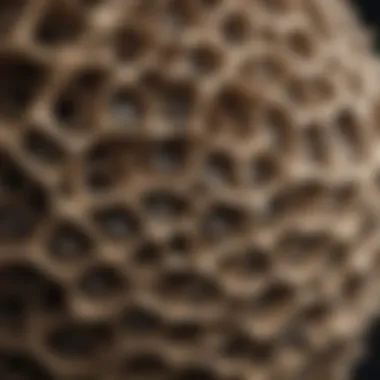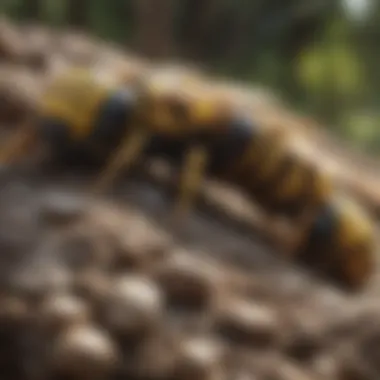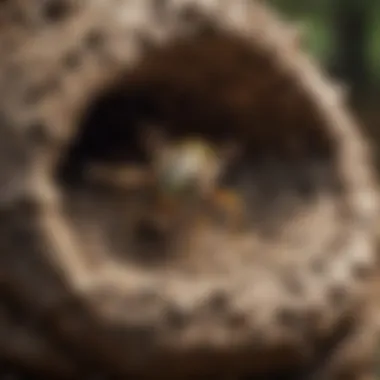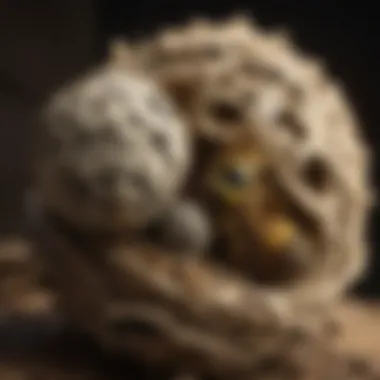Ultimate Guide to Safe Wasp Nest Removal Techniques


Intro
Wasp nests can be a growing concern for many homeowners and families. They present various risks, including painful stings and potential property damage. Understanding the nature of these insects and how to approach their removal is crucial. This guide will cover various aspects of wasp nest removal. It will look at safety precautions, identify common types of wasps, and suggest tools required for effective removal. For those who might find the task daunting, there will also be guidance on when to call a professional.
Animal Overview
Common Name and Scientific Classification
Wasps belong to several families, with the most recognizable being the yellowjacket (Vespula) and paper wasps (Polistes). These insects play important roles in the ecosystem, often acting as predators to provide pest control.
Physical Characteristics
Wasps can be distinguished by their slender bodies, narrow waists, and two pairs of wings. Their coloration ranges usually involves yellow and black, though some species exhibit more varied hues. The stinger is a notable feature, utilized for defense and to incapacitate prey.
Habitat and Distribution
Wasps nest in various locations, often selecting sheltered areas in trees, shrubs, eaves, or underground. Their distribution extends across many continents, including North America and Europe, thriving in gardens and woodlands.
Behavior and Social Structure
Communication Methods
Wasps communicate through pheromones and body language. For example, a wasp releasing alarm pheromones can alert others in danger. This is vital for protecting the nest and the colony's welfare.
Social Hierarchies
Most wasps display social behavior within their colonies. These groups often consist of a queen, workers, and drones. The queen lays eggs, while workers maintain the nest and care for the larvae.
Mating and Reproductive Behavior
The reproductive cycle begins in late summer when new queens mate. Once fertilized, they seek sheltered areas for hibernation, ensuring the survival of their species during colder months.
Conservation Status
Current Population Trends
Wasp populations fluctuate based on environmental factors. Their presence is crucial for biodiversity, but they face threats like pesticide use and habitat destruction.
Threats and Challenges
Wasp populations are challenged by urban development and climate change. These factors alter their habitats, impacting their survival and nesting patterns.
Conservation Efforts and Success Stories
Some initiatives promote awareness and protection of wasps due to their ecological roles. Local conservation groups often work to educate the public about their importance and to mitigate negative perceptions associated with these insects.
Understanding Wasp Nests
Understanding the dynamics of wasp nests is crucial when dealing with their removal. Wasp nests can not only pose a health risk due to stings but can also lead to significant damage to property. Knowing the specific characteristics of these nests, their construction, and the behavior of the wasps that inhabit them allows for safer and more effective removal strategies. This knowledge is vital for homeowners and outdoor enthusiasts alike, as it helps in taking informed actions, minimizing encounters, and understanding potential dangers.
What Are Wasps?
Wasps are insects that belong to the order Hymenoptera, which also includes bees and ants. Unlike bees, wasps have a slender body and do not have much hair, making them less effective at pollination. They play an important role in the ecosystem as they help control pest populations. Understanding what wasps are and their role in nature can shift the perspective from viewing them as mere pests to recognizing their ecological significance.
Types of Wasps That Build Nests
Caterpillar Wasps


Caterpillar wasps, known scientifically as Ichneumonidae, are often considered beneficial for agricultural practices. These wasps lay their eggs in or on caterpillars, which serve as a food source for their developing larvae. A key characteristic of caterpillar wasps is their incredibly long ovipositor, which they use to deposit eggs into the host caterpillar. This aspect makes them a popular choice in biological pest control. However, their presence may be confusing to those dealing with pest issues, as they themselves do not generally build nests like social wasps.
Social Wasps
Social wasps, like the yellow jacket and paper wasp, are perhaps the most recognized groups for nest building. These wasps work together in colonies to construct intricate nests from a paper-like material made from chewed wood fibers mixed with saliva. A notable feature of social wasps is their aggressive defense of the nest when threatened, which can pose risks to those nearby. Their social structure, with queens, workers, and drones, allows them to efficiently gather food and defend their territory. However, they can become a nuisance during late summer, prompting the need for effective removal strategies.
Solitary Wasps
Solitary wasps do not build nests collaboratively. Instead, each female constructs her own nest and provisions it for her offspring. Some common types include the mud dauber and digger wasp. A distinguishing feature is that solitary wasps generally are not aggressive and will only sting in defense. Their nests serve as a crucial part of their lifecycle, allowing the female to control food supplies effectively. They offer an interesting balance to the ecosystem but also highlight the need for proper identification when addressing wasp-related issues.
Life Cycle of Wasps
The life cycle of wasps is fascinating, often comprising four distinct stages: egg, larva, pupa, and adult. Understanding this lifecycle can assist in determining the best time for removal and managing any infestation. Each stage has its own characteristics and needs, and knowing these can significantly affect the approach taken in wasp nest removal. For instance, targeting the nest in the early stages of development can minimize reproductive success and prevent the spread of more aggressive wasps as the season progresses.
Identifying a Wasp Nest
Identifying a wasp nest is a crucial step in managing and removing these potential threats effectively. Recognizing the nest reduces the risk of disturbing the wasps, which can lead to stings and other dangers. With various species of wasps active in different environments, it is essential to understand their nesting habits and common locations. A precise identification also aids in selecting appropriate removal methods, whether DIY or professional. This knowledge can make a significant difference, especially for households with children or individuals with allergies.
Common Locations for Wasp Nests
Wasp nests can be found in diverse places, and their location directly influences the removal strategy. Here are some typical areas where you may encounter wasp nests:
- Under eaves and roofs: Many wasps prefer to build nests in shaded, sheltered areas. Check under eaves and roof overhangs for signs of activity.
- Trees and shrubs: Wasps often construct nests in trees or dense shrubs, where they feel secure and have easy access to food sources.
- Sheds and garages: These enclosed spaces provide protection from weather and predators, making them appealing for nesting.
- Ground nests: Certain wasps like yellow jackets build nests underground. Look for openings in the soil or disturbed earth.
Being aware of these common nest locations helps in planning search and removal efforts.
Visual Characteristics of Wasp Nests
Recognizing the visual traits of wasp nests is essential for identification. The nest's structure can provide clues about the wasp species and the status of the nest. Key characteristics include:
- Material Composition: Wasps create nests by chewing wood fibers and mixing them with their saliva. This results in a papery texture, often resembling a honeycomb structure.
- Shape and Size: Nests can vary significantly in size and shape. They can be spherical, oval, or teardrop-shaped. Some nests may grow as large as a soccer ball or even larger.
- Entry and Exit Points: Observing where wasps come and go can help determine the nest's location. Look for small openings, typically near the base or bottom of the nest.
Understanding these characteristics enhances the ability to correctly identify and approach wasp nests safely.
Signs of Wasp Activity
Detecting signs of wasp activity can help confirm the presence of a nest before attempting removal. Here are several indicators to look for:
- Increase in Wasp Sightings: Frequent sightings of wasps around your home indicate nearby nests, especially during peak activity seasons.
- Frantic Behavior: Wasps are notably aggressive when their nest is threatened. If you notice them swarm or dart around a specific area, that could indicate a nest.
- Food Sources: Wasps are attracted to sugary substances and protein. Outdoor areas with food waste or pet food can draw them in, signifying proximity to a nest.
By monitoring these signs, you can ascertain wasp activity and determine the best course of action for removal.
Preparing for Wasp Nest Removal
Preparing for wasp nest removal is a crucial step in ensuring both safety and effectiveness. Addressing a wasp problem without adequate preparation can lead to serious consequences, including stings and increased property damage. By assessing the situation, gathering the right tools, and following safety precautions, individuals can significantly reduce risks associated with wasp nest removal. This section focuses thoroughly on each element of preparation, emphasizing the importance of these aspects in successfully managing a wasp infestation.
Assessing the Situation
Before attempting to remove a wasp nest, it is essential to assess the situation properly. This involves evaluating the nest’s size and location, as well as the level of wasp activity. Larger nests typically contain a greater number of wasps, increasing the likelihood of aggressive behavior if disturbed. Evaluating the nesting location can reveal potential risks, especially if the nest is in a hard-to-reach area or near frequently used spaces, such as patios or garages.
Consideration should also be given to the time of day, as wasps are generally less active in the early morning or late evening. Observing these patterns can help in planning the removal to minimize encounters with the insects. Collecting this information allows for informed decisions on the methods and timing for removal, ensuring a methodical approach.
Gathering Necessary Tools and Supplies
To effectively handle wasp nest removal, certain tools and supplies are essential. Proper preparedness enhances outcomes and minimises unnecessary complications during the process.
Insecticides
Insecticides are a common choice for removing wasps. These chemical solutions are directly aimed at eliminating the insects quickly. The effectiveness of insecticides lies in their ability to cover a large area, ensuring that while targeting the nest, they also reach those wasps that attempt to escape. The key characteristic of insecticides is their formulation, which can vary from sprays to powders.


Some insecticides contain active ingredients like pyrethroids that act swiftly upon contact, making them popular among those removing nests. However, there are disadvantages, such as potential environmental impact and health risks to people and pets. Therefore, using insecticides requires caution and adherence to safety guidelines, particularly those outlined on product labels.
Protective Clothing
Protective clothing is vital to ensure safety during wasp nest removal. Wearing adequate protective gear helps shield the face, arms, and legs from potential stings. A key characteristic of protective clothing is that it is designed to cover all exposed skin. This is crucial since wasps can sting and cause allergic reactions.
A unique feature of protective clothing is its material, often thick and durable, which can provide a barrier against wasp stings. Overall, it is beneficial because it allows individuals to handle removal tasks with a greater sense of security. However, one disadvantage can be the bulkiness, which may hinder movement in tight spaces.
Ladders or Poles
Ladders or poles may be necessary for those dealing with nests located high in trees or on structures. These tools help provide the reach required to apply insecticides or physically remove the nest. The key characteristic of ladders or poles is their height and stability, which are essential for safely accessing difficult areas.
Using a sturdy ladder allows for a clear line of sight when dealing with the nest, which can enhance precision during removal. On the downside, using ladders or poles requires skill and caution, especially if the individual is not accustomed to working at heights.
Safety Precautions
Prioritizing safety precautions is indispensable during the wasp nest removal process. Several considerations can protect individuals from potential harm.
Understanding Allergies
For some individuals, wasp stings can trigger severe allergic reactions. Understanding allergies in this context is vital. Those with a known allergy should take extra care or consider having a professional handle the situation. A key characteristic of this precaution is that it can prevent life-threatening scenarios.
The unique feature of addressing allergies is that it allows individuals to create an effective safety plan. Ensuring everyone nearby knows the situation can add another layer of protection. However, the downside is that not everyone may be aware of their sensitivity until a sting occurs, which emphasizes the need for preventive measures.
Timing of Removal
The timing of removal is another critical factor. Timing this task during cooler parts of the day, such as early morning or late evening, is generally safer as wasps are less active. This is significant because working at less active periods minimizes the risk of aggressive behavior. A unique feature of this strategy is the reduction of stress both for the removal person and the wasps.
Nevertheless, planning can be limited by weather conditions and personal schedules, which may not always align with optimal times. Therefore, assessing these factors beforehand is crucial for a successful and safe removal.
In summary, proper preparation for wasp nest removal can significantly impact the overall effectiveness of the task. Making informed decisions about the assessment, necessary tools, and safety precautions is essential in handling the situation confidently.
Methods for Wasp Nest Removal
Removing wasp nests is critical to ensure safety around homes and outdoor areas. Wasps can be aggressive, and their stings may cause allergic reactions. Thus, understanding effective methods for nest removal is essential. In this section, we will explore various techniques, their effectiveness, and considerations to keep in mind.
Using Insecticides
Insecticides are a common choice for wasp nest removal. They are specially formulated to target and kill wasps quickly. The main advantage of insecticides is that they allow for distance application. This means the user can spray from a safe distance, minimizing the risk of getting stung. Many insecticides are aerosol-based, making them easy to use. It is important to carefully follow the instructions on the label for effectiveness and safety.
However, there are some downsides. Insecticides can pose risks to beneficial insects and the environment. Moreover, they may not be effective if used improperly. Therefore, users must consider not only their safety but also the potential impact on surrounding ecology.
Physical Removal Techniques
Physical removal can be effective but requires more caution and skill. The goal is to eliminate the nest manually, which may involve some risks but can be successful if done correctly. There are two notable methods in this category:
Knocking Down the Nest
Knocking down the nest is a direct approach for eliminating wasps. This method requires physical strength and quickness. The primary characteristic of this technique is its immediate effect on the wasps. If performed correctly, it can eliminate a large number of wasps swiftly. Using a long pole or a stick, you can knock down the nest from a distance.
However, this method has several drawbacks. If the removal is attempted without proper planning, it can provoke the wasps. They might swarm aggressively. Therefore, timing is essential, ideally at night when wasps are less active. Also, the user must be prepared for the possibility of stings. It is a risky option but can be effective if adequately executed.
Sealing Entry Points
Sealing entry points is a method that focuses on preventing future nesting rather than immediate removal. It involves identifying areas around homes where wasps may gain access and sealing them with various materials such as caulking or foam insulation.
The key characteristic of this approach is its preventive nature. It addresses the issue before it escalates. This is an important choice because it can eliminate the habitat without causing harm to the wasps immediately present. The unique feature of sealing entry points is that it can be completed as part of routine home maintenance. However, it does not eliminate existing nests and requires one to address current nests through other means.


Natural Removal Methods
Natural removal methods gain popularity among individuals seeking eco-friendliness. They typically involve using household items or less harmful substances to deter or remove wasps.
Water Dousing
Water dousing involves soaking the nest with water. This method primarily works by collapsing the nest structure and drowning the inhabitants. The primary characteristic of this technique is its simplicity. Anyone can perform it with basic tools like a bucket or a hose. The benefit of water dousing is that it reduces the risk of chemicals impacting the environment.
However, this method has drawbacks. Effectiveness can vary based on the size of the nest and the wasp species. In some cases, wasps may escape and become aggressive.
Essential Oils
Essential oils have become a popular choice for those looking to remove wasps naturally. Oils like peppermint or clove can be mixed with water and sprayed on the nest or surrounding areas. The key characteristic is their non-toxic nature, making them safe for other wildlife and pets. Using essential oils can deter wasps effectively while being less harmful.
While this method has advantages, it may require multiple applications for effectiveness. Its success also depends on environmental factors such as rain or temperature. Thus, exploring various options and combining methods may yield the best results.
It is essential to consider safety and environmental impact when choosing a wasp nest removal method.
Post-Removal Considerations
Post-removal considerations are critical to ensuring a complete and safe approach to dealing with wasp nests. After successfully removing a nest, there are several aspects to take into account. Proper disposal of the nest itself is important. It not only minimizes potential hazards but also eliminates any lingering pheromones that could attract other wasps. In addition to disposal, preventive measures are crucial. Taking the right steps will help avoid future infestations.
Disposing of the Nest
When disposing of a wasp nest, it’s essential to do so carefully. First, ensure the nest is entirely inactive before handling it. It’s better to wait a few days after removal to confirm that all wasps have left. Use a sealed plastic bag to contain the nest and any debris. This approach prevents the spread of any pheromones that may attract new wasps. Following disposal, the area where the nest was must be cleaned thoroughly to eliminate any traces that might invite unwelcome visitors.
Preventing Future Nesting
Preventing future nesting is vital for maintaining a wasp-free environment. Effective control can be achieved through two main strategies: removing attractants and conducting regular inspections. Each contributes significantly to reducing risks associated with wasps.
Removing Attractants
Removing attractants is an essential step in deterring wasps. Wasps are naturally drawn to food sources, which can include discarded fruits, sugary substances, and even pet food left outside. By eliminating these potential food sources, homeowners can greatly decrease the likelihood of a nest appearing nearby. A key characteristic of this method is its simplicity. It requires minimal resources and can be implemented immediately after nest removal. The unique feature of this strategy is its proactive nature. It not only addresses the immediate problem but also sets the stage for a long-term solution.
Regular Inspections
Regular inspections are a necessary practice for maintaining control over wasp populations. They allow homeowners to spot early signs of nesting before they escalate into a more significant issue. A significant advantage of frequent checks is that they can be easily added to routine home maintenance tasks. Discovering new nests promptly can be vital to avoiding stings and property damage. The unique aspect of regular inspections is their adaptability; they can be done at any time of the year, ensuring that your property stays safe and attractive for family and pets.
Effective post-removal actions not only enhance safety but also reduce the chances of future infestations, making them indispensable steps in wasp management.
When to Call Professionals
Wasp nest removal can be risky. It requires thoughtful consideration about tackling the task oneself or enlisting professional assistance. This section outlines when seeking expert help is necessary. The goal is to minimize risk, ensure effective removal, and avoid potential injuries or allergic reactions.
Determining the Need for Experts
Size of the Nest
The size of the nest is a critical factor in deciding on professional intervention. Larger nests often indicate a larger population of wasps. This increases the chance of aggressive behavior when the nest is disturbed. A key characteristic of large wasp nests is their complexity. They can house hundreds or even thousands of wasps, often outnumbering the capabilities of a casual homeowner.
Choosing to handle a large nest personally can lead to a multitude of problems. For instance, the large number of wasps might overwhelm an individual, leading to a higher likelihood of getting stung. In addition, larger nests require specialized tools and techniques for safe removal. In contrast, a smaller nest can often be managed with basic removal strategies and precautions. Thus, recognizing the significance of nest size can guide the decision to call for professionals.
Location Accessibility
Location accessibility plays a substantial role in determining whether to hire pest control services. If a nest is situated in a hard-to-reach area, such as high in tree branches or within building structures, it could pose a considerable challenge. The difficulty in accessing these nests can increase the risk to an individual during removal efforts. Moreover, wasps may perceive any disturbance as a threat, resulting in aggressive behavior.
Specialized equipment helps professionals reach nests in inaccessible areas safely. They can also utilize techniques that ensure the wasps are dealt with efficiently, without escalating any dangerous situations. This advantage is important when facing nests located in confined or elevated spaces. In summary, proximity and difficulty of location should influence the decision about engaging expert help.
Choosing the Right Pest Control Service
Once the decision has been made to seek professional help, carefully selecting a pest control service becomes crucial. Start by researching local options, focusing on companies with experience in wasp removal. Look for reviews from previous clients that indicate satisfactory outcomes. Check their certifications and methods used for nest removal.
Another aspect to consider is the cost of services. Ensure that the selected service offers transparent pricing without hidden fees. Some pest control companies may also offer guarantee services, which can provide peace of mind after removal has been completed.
Before making a decision, it is wise to gather a few quotes from different services to assess your options effectively.







